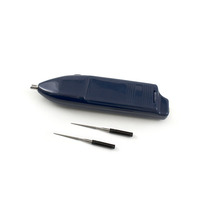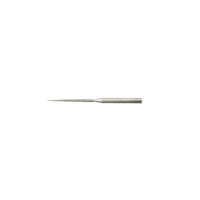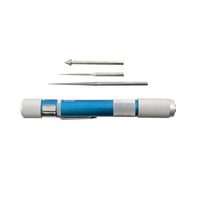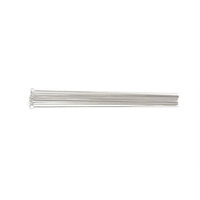Beader’s dictionary
B
BATTERY OPERATED BEAD REAMER (See products)
Tool that has a handle and two interchangeable diamond file tips of various sizes. It cleans, regularizes or widens beads. Battery operated, it’s faster than the manual one and is particularly effective with organic beads such as pearls, seashell, coral and wood beads. Submerging the bead in a recipient filled with water during filing is recommended to prevent the beads from overheating. Replacement tips are sold separately.
C
CAMEO
A cameo is a low-relief glyptic art carving technique (art of stone carving in relief or intaglio). This technique is used on materials made of layers of colors. The sculptor must carve while taking into account the different layers of color and depth to play with so that the various colors are positioned in the right places. Cameos representations are often found as a bust of an influential political, cultural or religious character. Hence, the term "cameo" also refers to the resulting object of the carving.
The most popular stratified materials that are used are onyx, banded agate, sardonyx, carnelian-onyx, chalcedony, the shell from layered seashells and glass. Sometimes, the color differences are exacerbated by dye. White strata, as they are very compact, do not stain, unlike the softer strata.
Stone cameos are very expensive, thus they were replicated in materials such as shells, glass, coral or lava. Today, we also find imitations made of various other materials.
A little bit of history: The cameo was very fashionable in Classical Antiquity then forgotten and resurfaced during Renaissance as Napoleon was an avid cameo collector and he instituted a special school to promote the engraving of stones.
CORAL (See products)
Coral is a microscopic animal which, throughout his life builds its shell out of limestone, calcium carbonate. When corals gather in great numbers (millions) they form coral reefs.
The red coral as well as the black coral are the most sought varieties of corals in the jewelry making industry. The red corals are classified by the intensity of their shade of red. The black coral is now an endangered specie and thus protected by law.
The pink coral also prized, is known as angel skin. This white coral is very sought although only when of the purest white shade.
The alternative to the red coral is the bamboo coral. Its lighter and less costly than the red coral. The bamboo coral’s name comes from it’s bony tree branch-like shape that resembles a bamboo plant. It starts off with a whitish shade but cant easily be dyed. As this coral abounds, it is not an endangered specie.
The sponge coral is also an alternative to the red and bamboo coral. This coral’s aspect is a cross between an algae and a mushroom, because of its sponginess, thus the name “sponge”. It has a rough texture however it can easily be polished and dyed.
G
GEM
Gems are minerals (like diamonds) or organic (like pearls, amber and coral) material used in jewelry, and silverware. Some crystalline aggregate like the lapis-lazuli or even some stones such as marble-onyx are also called gems. For matter to be considered a gem, it must be attractive and solid enough to withstand constant manipulations. Other matters such as ivory, jet carbon, glass and fossils are at times considered gems. Synthetic stones are not considered to be gems.
M
T
Twisted beading needle (See products)
Needle made from a twisted wire, which loops at the end, enabling the insertion of a string. Thinner and more flexible than other needles, this one is ideal to use when threading strings through beads with a narrow hole such as fresh water pearls and seashells, corals and other gems.















